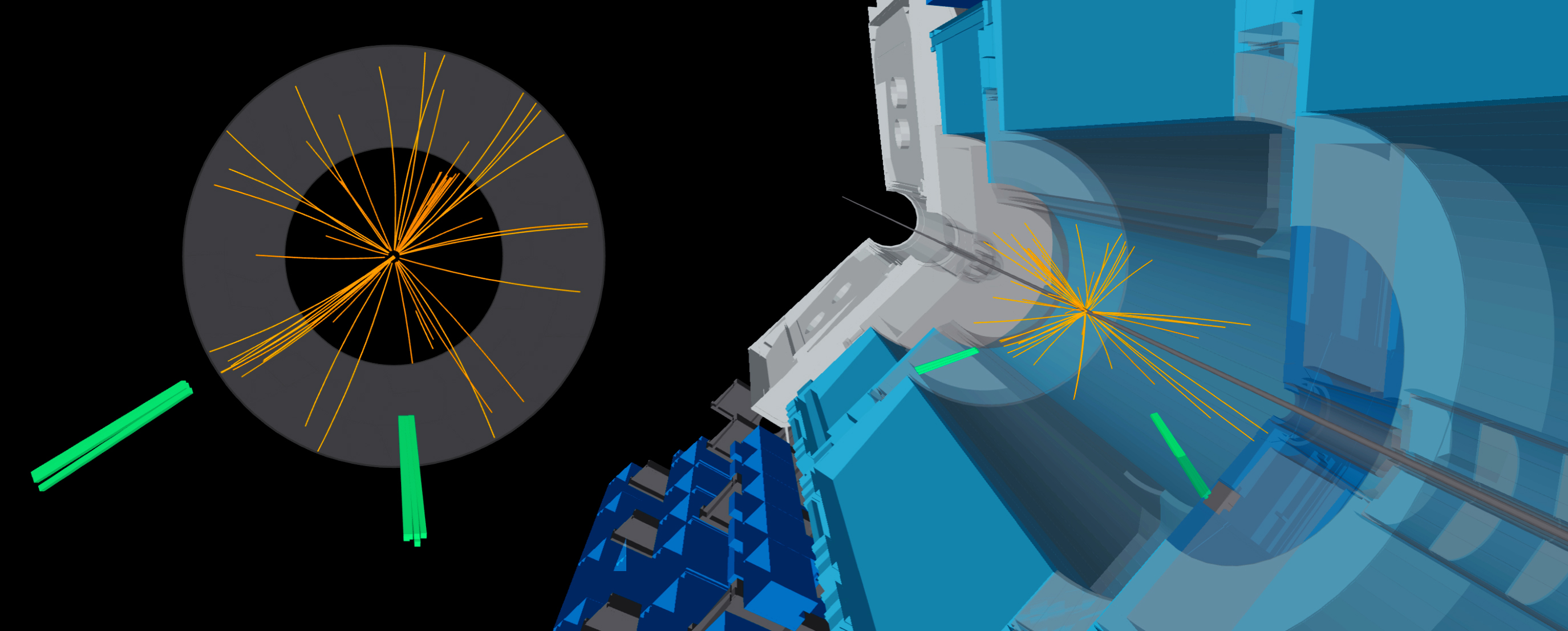ATLAS measures Higgs boson mass with unprecedented precision
21 July 2023 | By
In the eleven years since its discovery, studies of the Higgs boson have become a central avenue for shedding light on the fundamental structure of the universe. Precise measurements of Higgs boson properties are among the most powerful tools physicists have to put pressure on the Standard Model – and now, it’s the turn of the Higgs boson mass.
The mass of the Higgs boson (mH) is not predicted by the Standard Model, and must be determined experimentally; a precise assessment of its value is of paramount importance in particle physics. The interaction (or coupling) strengths of the Higgs boson with Standard-Model particles depends on the Higgs boson mass, and can only be calculated once the value of the mass is known. More importantly, the value of the Higgs boson mass is intimately related to the properties of the Higgs potential – which determines the stability of the electroweak vacuum, and potentially the fate and evolution of our universe.
This week, at the Lepton-Photon Conference in Melbourne (Australia), the ATLAS Collaboration presented its measurement of the Higgs boson mass in studies of Higgs decays to two photons using the full LHC Run -2 dataset (“H→γγ” or the diphoton channel), and a new combination of this measurement with the 2022 measurement of the Higgs boson mass in studies of the Higgs decays to four leptons (the “H→4l" channel).
The new H→γγ result significantly improves upon the previous ATLAS measurement in this channel, benefiting both from the full LHC Run-2 dataset – reducing the statistical uncertainty by a factor of two – and from dramatic improvements to the calibration of the photon energy response – reducing the systematic uncertainties by nearly a factor of four.
The new ATLAS result is the most precise determination of the Higgs boson mass yet – achieving a remarkable accuracy of 0.09% for this fundamental parameter.
Sporting a new photon calibration
Key to this precise new H→γγ measurement was a revamped calibration of the photon energy response that, over the past few years, physicists worked to improve. The photon energy calibration was optimised on detailed Monte Carlo simulations of the ATLAS sub-detectors using machine learning techniques. This approach assumed all the details of the detector response in data were precisely understood; when discrepancies between simulations and data were observed, corrections were applied.

The recent convergence of studies of these corrections resulted in multiple improvements. The new calibration sports a more accurate estimation of the material in front of the ATLAS calorimeter; an improved treatment of the response from the electromagnetic calorimeter’s readout electronics; the intercalibration of the response of the calorimeter longitudinal layer; and dedicated corrections for the difference in the development of electromagnetic showers induced by photons and electrons in the calorimeter. For their new measurement, ATLAS researchers revisited all the ingredients of the photon calibration with these improvements in place, also profiting from the full LHC Run-2 dataset.
For the final step in their calibration procedure, physicists used a clean sample of Z→ee events and matched the response in data with those from simulations. This was also measured as a function of the electron transverse momentum – a novel approach that allowed physicists to further reduce systematic uncertainties. For photons coming from a H→γγ decay that do not interact before the electromagnetic calorimeter, the uncertainty on the calibrated energy was typically improved by 30% in the central part of the calorimeter, and up to a factor two in the endcap region.
Unprecedented precision and the power of channel combination
The ATLAS Collaboration has measured the Higgs boson mass in the H→γγ channel to be: mH = 125.22 ± 0.11 (stat.) ± 0.09 (syst.) GeV = 125.22 ± 0.14 GeV. This new result combines the Run-2 result with the measurement obtained in Run 1. With a relative uncertainty of 0.11%, this is the most precise measurement of the Higgs boson mass from a single channel to date.
When this new measurement in the diphoton channel is combined with the Higgs boson mass measurement the H→4l channel released in 2022, the combined value of the Higgs boson mass is: mH = 125.11 ± 0.09 (stat) ± 0.06 (syst) GeV = 125.11 ± 0.11 GeV.
Currently, this stands as the most precise determination of the Higgs boson mass, achieving a remarkable accuracy of 0.09% for this fundamental parameter. This accomplishment is a testament to the ATLAS Collaboration’s long-standing commitment to understanding the detector and to developing advanced calibration techniques – enabling physicists to unravel the mysteries of the Higgs boson with unprecedented precision.

Learn more
- ATLAS sets record precision on Higgs boson’s mass, CERN Media Update, 21 July 2023
- Measurement of the Higgs boson mass with H→γγ decays in 140 fb–1 of 13 TeV proton–proton collisions with the ATLAS detector (ATLAS-CONF-2023-036)
- Combined measurement of the Higgs boson mass from the H→γγ and H→ZZ*→4l decay channels with the ATLAS detector using 7, 8 and 13 TeV proton–proton collision data (ATLAS-CONF-2023-037)
- Measurement of the Higgs boson mass in the H→ZZ*→4l decay channel using 139 fb–1 of 13 TeV proton–proton collisions recorded by the ATLAS detector at the LHC (arXiv: 2207.00320)
- Measurement of the Higgs boson mass in the H and H→γγ channels with 13 TeV proton–proton collisions using the ATLAS detector (Phys. Lett. B 784 (2018) 345)
- Electron and photon energy calibration with the ATLAS detector using LHC Run-2 data (CERN-EP-2023-128, link coming soon)
- M. Sher, Electroweak Higgs Potentials and Vacuum Stability (Phys. Rept. 179 (1989) 273); G. Degrassi et al, Higgs mass and vacuum stability in the Standard Model at NNLO (arXiv:1205.6497)




